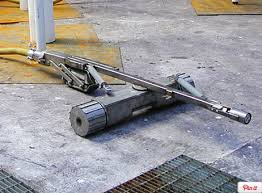Robots have been used in nuclear facilities for a long time.Scenarios such as maintenance tasks in nuclear facilities or even disasters like radioactive leaks or search and rescue operations have proven to be quite successful. We are talking about robotic arms or remote operated vehicles with some end effectors built in to handle dangerous situations.”
1986: Chernobyl’s robot trouble–During the Chernobyl nuclear incident, the Soviet authorities in charge of cleaning up nuclear waste developed around 60 unique remote-controlled robots to spare human workers from radioactive exposure. The total cost of the clean-up operation was $2bn. Designs included the STR-1 robot, which resembles a moon buggy. It was placed on the roof of the nuclear plant and used to clean upparts of the destroyed reactor. Another design for the purpose of debris cleaning was the Mobot, developed by Moscow State University. It was a smaller version of a loader used in construction, with a front-end bucket used to scoop up debris.
The problem was that cleaning up nuclear waste required more skills than the robots could provide, eventually resulting in the authorities sending in soldiers to perform most of the decontamination works. Radiation was so high that each worker could only spend 40 seconds inside or near the facility; 31 died from exposure, while 237 suffered from acute radiation sickness.
2008: Cleaning up nuclear waste at Hanford Nuclear Reservation. The Hanford Nuclear Reservation in the US has been somewhat of a hub for nuclear waste innovation. This is because scientists, and their robot friends, are faced with the task of emptying nuclear and chemical waste tanks the size of around 150 basketball courts before the waste reaches the Columbia River. Exposure to the material would kill a human instantly.
Luckily, Hanford has developed a few automated machines thatare specifically designed for different parts of the job. Take Foldtrack, for example, which can access the tanks through one-foot-wide pipes in the roof bysplitting into a string of pieces, and then rebuilding itself like a Transformer once inside. The remote-controlled robot uses a 3,000psi water cannon to blast nuclear sludge off the walls of the tank and pump it out. Upon completion, scientists are forced to leave the $500,000 robot in the tank due to the high levels of contamination.

sand mantis 
tank crawler 
Sunfish 
foldtrack
Another robot, the Sand Mantis, looks like a fire hose on wheels. However, it comes packed with power, with the ability to blast tough toxic salts that build up in waste tanks with its 35,000psi water cannon. For comparison, a regular firehose has around 300psi of pressure. In order to support the huge power, the orifice of the hose is made of gems, such as sapphires, which can withstand the pressure….Finally, the Tandem Synthetic Aperture Focusing Technique,or Tank Crawler, locates cracks or corrosion in Hanford’s waste storage tanks using ultrasonic and electrical conductivity sensors.
2011: Fukushima—Previously designed robots failed to visually inspect the reactor, either breaking due to high radiation or by getting stuck in the confined spaces. That was until Toshiba’s senior scientist in its technology division, Kenji Matsuzaki, developed the Little Sunfish – an amphibious bread loaf-sized robot that could slip into the 5.5-inch reactor pipelines.
In 2017, the Sellafield nuclear site in the UK, scientists have been working on methods to clean up the vast amounts of nuclear sludge from its First-Generation Magnox Storage Pond, as part of decommissioning efforts said to cost around £1.9bn each year. The size of two Olympic swimming pools, the storage pond contains large amounts of nuclear sludge from decaying fuel rods stored below the surface. While robots have been designed to reach the depths of the pond and remove nuclear waste, none proved to be very successful, until Cthulhu– Collaborative Technology Hardened for Underwater and Littoral Hazardous Environment. Cthulhu is a tracked robot that can move along the bottom ofthe storage pond, using whisker-like sensors and sonar to identify and retrieve the nuclear rods.
2018: The South West Nuclear Hub at the University of Bristol inthe UK is collaborating with Sellafield to develop a nuclear waste robotic suit for humans, taking inspiration from the comic book hero Iron Man.
Excepts from Cherno-bots to Iron Man suits: the development of nuclear waste robotics,, Power-Technology. com, Dec. 4, 2018





